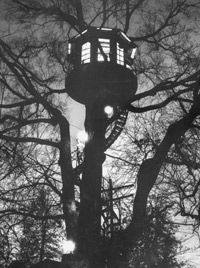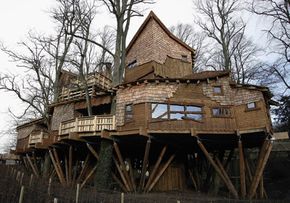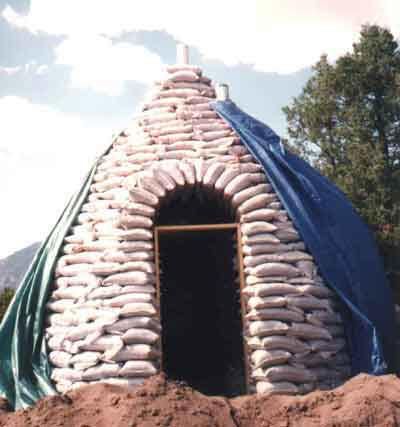Tree-House Construction
If you don't have the time or the skill to build your own tree house, consider hiring a licensed and bonded contractor to do the work for you. Some are so passionate about building tree houses they will travel to wherever you live to work with you.
If you're a do-it-yourself type tackling the construction of your tree house, stay safe in the off-the-ground work zone by wearing a hard hat, protective goggles and safety harness. Tie your harness and your ladder(s) to a strong tree branch to minimize your chance of falling. Also consider renting scaffolding instead of leaning ladders against the tree trunk. Familiarize yourself with your tools, especially if any are newly purchased for your project. And always keep a first-aid kit nearby.
Advertisement
Are tree houses safe? In a healthy tree with strong building materials, yes. Build tree houses close to the ground, no higher than 10 feet (3 meters) up. Use tall railings and sturdy, well-placed ladders protect children (and adults) from dangerous falls. Consider acrylic plastic sheets in place of glass windows. And avoid splinters by sanding down rough edges.
It's also important to protect the tree during the construction process and beyond. Tree houses do cause mild harm to trees, even when using practices that minimize damage.

Remember that trees are living, growing things. Allow for future growth in your construction plan, and don't cut away branches or pieces of the trunk to make way for your tree house's support system or remove large amounts of bark or wood, which could expose the tree to infection and disease.
Construction techniques also help protect trees from damage. A tree house can be broken down into several parts: the platform, windows and doors, decks and railings, and access.
Building the platform is the first step to assembling your tree house because it is what provides the support system. The platform should be built close to the trunk, with space to accommodate the tree's future growth. It should be level and balanced centrally.
Single, large bolts should be used for main supports rather than nails. Nails are weak, can easily loosen, and because many are needed, it's likely they'll damage the tree. As the tree continues to grow, it will expand over the bolts, in a process called compartmentalization. This creates a tight bond between tree and tree house over time. Another option is Garnier Limbs (GLs), artificial steel limbs created by professional tree-house designer Michael Garnier. GLs are bolted into the tree and are able to support up to 8,000 pounds (3,629 kilograms), significantly increasing the safety of the structure [source: Treehouse Workshop].
Once the platform is complete, it's time to add the floor, walls then roof, which can be preassembled on the ground to reduce the amount of construction done above ground. To ensure your tree house lasts for years and isn't damaged when the tree grows or sways in the wind, be sure no part of your tree house touches the tree; it should all rest on the support system. Windows, doors, decks and other amenities are optional, but railings are a necessity.
But how will you get up there after it's done? Depending on how high you've built your tree house, you may do well with a rope or wooden ladder. For tree houses that are way up high, consider steps -- spiral or straight -- with railings for safety. You can also use a combination of rope walkways and landings or even a pulley system. The possibilities are endless.
For more information about house construction and tree houses, look over the resources on the next page.


